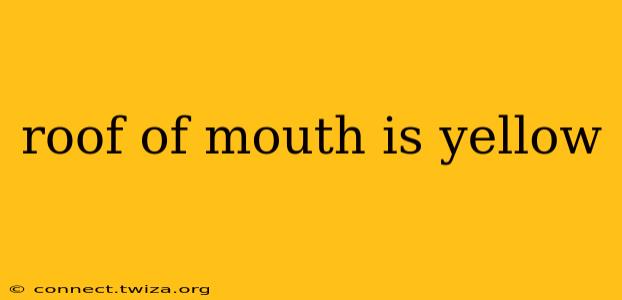A yellow roof of the mouth, or palate, can be alarming, but it's important to understand that several factors can cause this discoloration. While some are harmless, others may indicate an underlying health issue requiring medical attention. This comprehensive guide explores the potential causes of a yellow palate, helping you understand when to seek professional help.
What Causes a Yellow Roof of the Mouth?
The color of your mouth's roof is usually pale pink. A yellow tinge can arise from various sources, including:
-
Dehydration: When you're dehydrated, your saliva production decreases. This can lead to a build-up of debris and bacteria, potentially causing a yellowish discoloration. Staying well-hydrated is crucial for maintaining oral health.
-
Smoking and Tobacco Use: Nicotine and other components in tobacco products stain the soft tissues in your mouth, including the palate. This staining can range from a slight yellowing to a more pronounced brown or even black discoloration. Quitting smoking is beneficial for overall health and significantly improves oral hygiene.
-
Food and Drinks: Certain foods and beverages, such as curry, turmeric, and some brightly colored candies, can temporarily stain the roof of your mouth. This staining is usually superficial and washes away with regular brushing and rinsing.
-
Poor Oral Hygiene: Insufficient brushing and flossing allow plaque and bacteria to accumulate, leading to a yellow film or coating on the palate. Regular and thorough oral hygiene practices are fundamental to preventing discoloration and maintaining healthy gums and teeth.
-
Medications: Some medications can cause changes in saliva production or alter the natural color of the mouth's tissues. This is a less common cause but should be considered if other possibilities are ruled out.
-
Jaundice: This condition, characterized by yellowing of the skin and whites of the eyes, can also cause the roof of the mouth to turn yellow. Jaundice is typically caused by liver problems, such as hepatitis or cirrhosis. It's a serious medical condition requiring immediate medical attention.
-
Oral Thrush (Candidiasis): This fungal infection can appear as white or yellow patches on the palate. It's often associated with a weakened immune system or antibiotic use.
-
Hyperbilirubinemia: This is a condition where there's too much bilirubin in the blood. Bilirubin is a byproduct of the breakdown of red blood cells. High levels can lead to yellowing of the skin and mucous membranes, including the roof of the mouth.
Is a Yellow Roof of the Mouth Serious?
The seriousness of a yellow roof of the mouth depends entirely on the underlying cause. While temporary staining from food or poor hygiene is usually not a cause for concern, jaundice and oral thrush require medical attention. If the yellowing is accompanied by other symptoms like fever, fatigue, pain, or changes in bowel movements, it warrants immediate consultation with a doctor.
When Should I See a Doctor About a Yellow Roof of the Mouth?
You should schedule an appointment with your doctor or dentist if:
- The yellowing is persistent and doesn't improve with good oral hygiene.
- The yellowing is accompanied by other symptoms, such as pain, fever, fatigue, or changes in bowel movements.
- You suspect you may have jaundice.
- You have a weakened immune system and notice yellow patches on your palate.
How Can I Prevent a Yellow Roof of the Mouth?
Practicing good oral hygiene is crucial:
- Brush your teeth twice a day with fluoride toothpaste.
- Floss daily to remove food particles and plaque between teeth.
- Rinse your mouth with water or mouthwash after meals.
- Stay hydrated by drinking plenty of water.
- Avoid smoking and tobacco products.
- Limit consumption of foods and drinks that can stain your mouth.
What other symptoms might accompany a yellow roof of the mouth?
This depends on the underlying cause. Jaundice, for example, often presents with yellowing of the skin and eyes, dark urine, and light-colored stools. Oral thrush might be accompanied by white or yellow patches in the mouth that are sometimes painful or have a cottage cheese-like appearance. Pain in the mouth or throat could accompany certain infections. Fatigue and fever are non-specific symptoms that can indicate a more serious underlying condition requiring prompt medical investigation.
How is a yellow roof of the mouth diagnosed?
Diagnosis usually begins with a thorough examination by a doctor or dentist. They will inquire about your medical history, lifestyle, and any other symptoms you're experiencing. Further investigations might include blood tests (to check liver function and bilirubin levels), a physical examination, and potentially a swab test to identify any fungal infections like oral thrush.
By understanding the various causes of a yellow roof of the mouth and knowing when to seek medical attention, you can take proactive steps to maintain your oral health and overall well-being. Remember, early diagnosis and treatment are essential for managing any underlying health issues.
